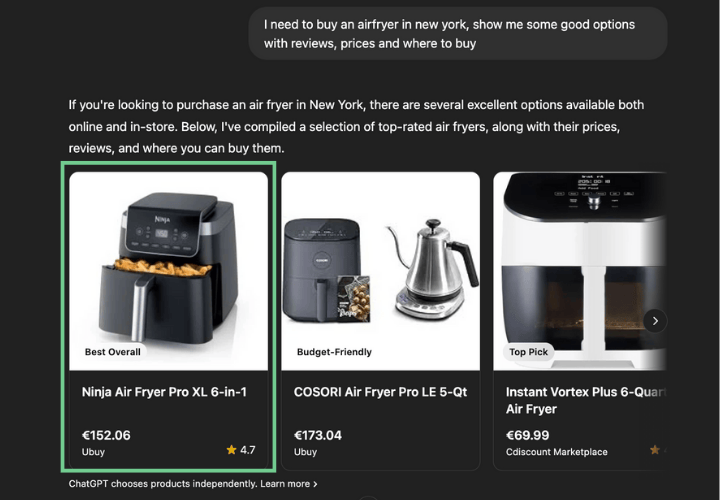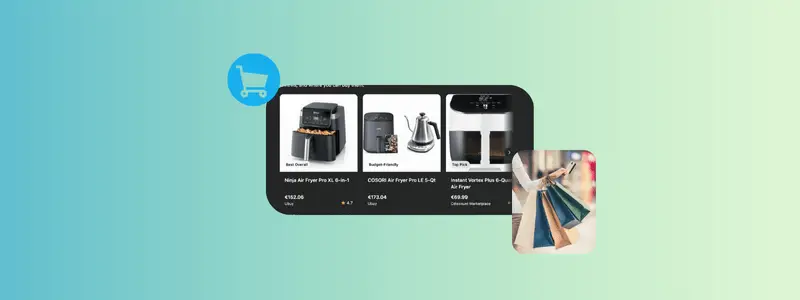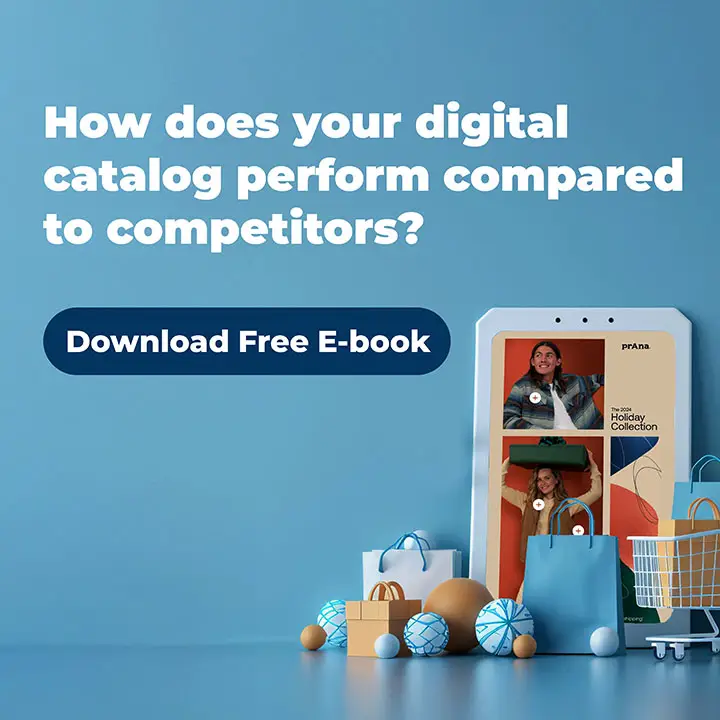One of the toughest challenges marketers face is increasing reach to new potential customers in a sustainable and affordable way. With the launch of ChatGPT Shopping, OpenAI has handed retailers a powerful new tool -free reach. This new capability helps shoppers discover and compare products directly within the app, offering AI-powered, tailored recommendations. For retailers, it unlocks a valuable new channel to connect with high-intent buyers, without relying on paid ads or complex integrations. With over 400 million weekly users, ChatGPT offers access to a vast and growing audience.
But how does it work, and more importantly, how can you ensure your products appear in these recommendations?
This guide explains ChatGPT Shopping, how it chooses which products to show, and what steps you can take to make your catalog eligible for inclusion.
What Is ChatGPT Shopping?
ChatGPT Shopping is an AI-powered discovery feature built into OpenAI’s ChatGPT platform. When users ask product-related questions, like “What’s a good laptop for under $1000?” or “Best moisturiser for sensitive skin?”. ChatGPT pulls relevant product listings and summarizes key features in a clean, ad-free interface.
Here’s what sets it apart from traditional search engines:
- It’s not ad-driven: ChatGPT doesn’t promote paid placements. Results are selected based on relevance, usefulness, and user intent.
- It’s personalized: Over time, it can tailor product suggestions to users’ preferences (when memory is enabled).
- It’s partner-integrated: Products are sourced from third-party platforms like Shopify, Amazon, Instacart, and others, using structured metadata and product feeds.
ChatGPT’s shopping feature is rolling out to users globally, including in South Africa, and is expected to grow significantly in reach.

How Does ChatGPT Choose Which Products to Show?
ChatGPT uses a combination of structured data, third-party feeds, and natural language understanding to surface products that match a user’s query.
Here’s what influences product visibility:
- Structured metadata: The platform relies on data from product feeds or schema markup to understand pricing, availability, and features.
- Relevance to user queries: The AI interprets the question and surfaces products that best match the user’s stated needs.
- Product description clarity: The easier it is to understand your product, the more likely it is to be featured.
- Trusted sources: ChatGPT currently integrates with select platforms (Shopify, Amazon, etc.), prioritizing retailers with up-to-date feeds.
How to Get Your Products Featured in ChatGPT Shopping: A 5-Step Plan
While OpenAI hasn’t launched a self-service portal for retailers yet, there are clear steps you can take to boost your visibility in ChatGPT’s shopping results.
1. List Your Products on Supported Platforms
ChatGPT sources many of its shopping results via integrations with third-party providers like Shopify and Amazon.
- If you run a Shopify store, ensure your product feed is live and includes all required fields.
- Use apps or plugins that automatically generate structured data (such as Shopify’s “Product structured data” app).
- For custom sites, ensure your product catalog is submitted to Google Merchant Center or similar platforms that ChatGPT may tap into via data partners.
Pro tip: The easier third-party data sources to read your product info, the easier it is for ChatGPT to recommend it.
2. Add Structured Data to Your Website
Structured data helps search engines and ChatGPT understand your product, its cost, and whether it’s in stock.
Use Schema.org markup with Product, Offer, and AggregateRating tags. Include details like:
- Product name and description
- Brand
- Price and currency
- Stock availability
- Images
- Ratings and reviews
Use Google’s Rich Results Test to validate your markup.
3. Craft Clear, Helpful Product Descriptions
AI thrives on context. Make your product pages descriptive, benefit-driven, and human.
- Avoid keyword stuffing—write naturally, like you’re speaking to a curious shopper.
- Start with what the product does and why it matters.
- Include unique use cases or key differentiators.
- Incorporate customer questions as headers (e.g., “Is this waterproof?” or “What skin type is this for?”).
Tip: A good description increases both SEO value and ChatGPT relevance.
4. Optimize Your On-Site SEO
Strong SEO makes it easier for Google and ChatGPT’s shopping engine to find and trust your products.
- Use meaningful, keyword-rich page titles and headers.
- Include alt text for all product images using descriptive language.
- Keep URLs clean and descriptive (e.g., /products/lightweight-camping-tent).
- Embed FAQs, reviews, or user-generated content where relevant.
This boosts your visibility not just in ChatGPT but in traditional search, too.
5. Stay Tuned for OpenAI’s Retailer Tools
OpenAI has stated that it plans to expand the program to allow merchants to submit their product feeds directly. While this functionality is not yet public, you can:
- Bookmark OpenAI’s help page on shopping.
- Subscribe to updates on openai.com/blog.
- Be ready to register interest or join a waitlist as tools become available.
Merchants who are early adopters of new formats typically see first-mover advantages.
Shopify Integrations Make It Even Easier
If you’re using Shopify, integrating your store with tools that generate product feeds and digital catalogs can make it much easier to surface your products in ChatGPT Shopping.
These integrations often sync your product data automatically, so updates to pricing, inventory, and descriptions are always current. Importantly, many of these tools allow you to turn your products into digital catalogs that are fully SEO-optimized, complete with crawlable text, product links, and metadata. Unlike static PDFs, these catalogs can rank in search engines and be indexed by AI systems, giving your products an additional, highly discoverable format online. This significantly boosts your chances of being featured when users search for items like yours.
You’re halfway there if you’re already active on Shopify or Amazon and prioritise SEO
ChatGPT Shopping offers a unique, ad-free way for consumers to discover products they need, powered by the world’s most popular conversational AI. For retailers, it’s a chance to reach high-intent shoppers in a natural, AI-assisted environment.
The best part? You don’t need to pay to play. By focusing on accurate, structured data, clear product content, and platform integrations, you can position your catalog for success as this new shopping channel grows.


